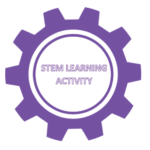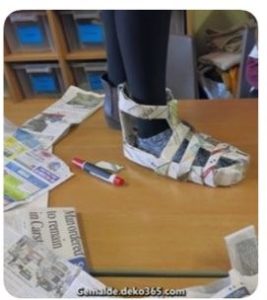
STEM Learning Activities – Engineering Mini Challenges
Mini Challenge 1: Newspaper Shoes

Materials required – Newspaper, masking tape (pre-determined length depending on Stage group), pencil, paper (for brainstorm and design) andiSTEM + poster
Define the problem (2 mins): In pairs or small groups of 3 or 4, design and make a shoe for someone (high heel, footy boot, gum boot). Students must be able to identify the function of the shoe and who would wear it
Identify constraints (8 mins): Provide students with the constraints, such as amount of masking tape, newspaper and time frames for each group. Write this up on the board and/or provide verbal reminders throughout the challenge
Brainstorm and design (10 mins): Provide students with blank paper and markers to brainstorm ideas and sketch a design. Encourage turn-taking and thinking ‘outside the box’. Students need to consider the function of the shoe and who the intended audience is (the wearer)
Make and test (20 mins): Provide groups their making materials (e.g. 10 cm masking tape and 10 sheets of newspaper)
Communicate/present (20 mins): Use this time to encourage whole-class positive critical feedback for each group as they present their product. Ask students to reflect on their group’s teamwork and communication skills.
Extension:
- Challenge students to make other items of clothing
- Modify the materials available
Mini Challenge 2: Floaty Challenge
 Materials required – Newspapers, paddlepop sticks, masking tape, corks, small sticks from outside, sticky tape, action figures and iSTEM+ poster
Materials required – Newspapers, paddlepop sticks, masking tape, corks, small sticks from outside, sticky tape, action figures and iSTEM+ poster
Define the problem (2 mins): Your action figure is nervous about going swimming. With a partner, design a floatation device to make them feel better
Identify constraints (8 mins): Give each group different materials to work with and the time frame they have to work within
Brainstorm and design (10 mins): Ask students about the properties of their group’s materials. What are the advantages and disadvantages of their material?
Make, test and improve (20 mins): This is the ‘trial and error’ phase. Encourage students to give feedback to each other and suggest improvements. If something is not working, why do they think it does not work? What else could they try?
Communicate/ Present (20 mins): Use this time to encourage whole-class positive critical feedback for each group as they present their product. Get students to analyse the effectiveness of each material for this task (material suitability for purpose). Were some materials more suited to this challenge than others? What if we could combine materials? Encourage creative thinking. Write ideas up on a class ‘wonder wall’ to either visit at a later date or lead into extension tasks.
Mini Challenge 3: Bridge Challenge
 Materials required – Pasta, paddlepop sticks, straws, newspaper, masking tape and iSTEM+ poster
Materials required – Pasta, paddlepop sticks, straws, newspaper, masking tape and iSTEM+ poster
Define the problem and identify constraints (5 mins): In small groups of 3 to 4, use the materials provided to build a bridge that can hold a specific object (this may be the action figure used in the previous challenge, or something else that the students come up with). Try to incorporate student voice and choice when defining challenges.
Brainstorm and design (10 mins): Encourage students to think about the properties of the materials and how they could be used
Make, test and improve (25 mins): Encourage students to trial different materials and shapes within the design to improve the bridge’s strength
Communicate/ Present (30 mins): Whole-class feedback. Which design worked best? Why? Think about the materials and the design (shapes). Ask each group to reflect on their work as a team
